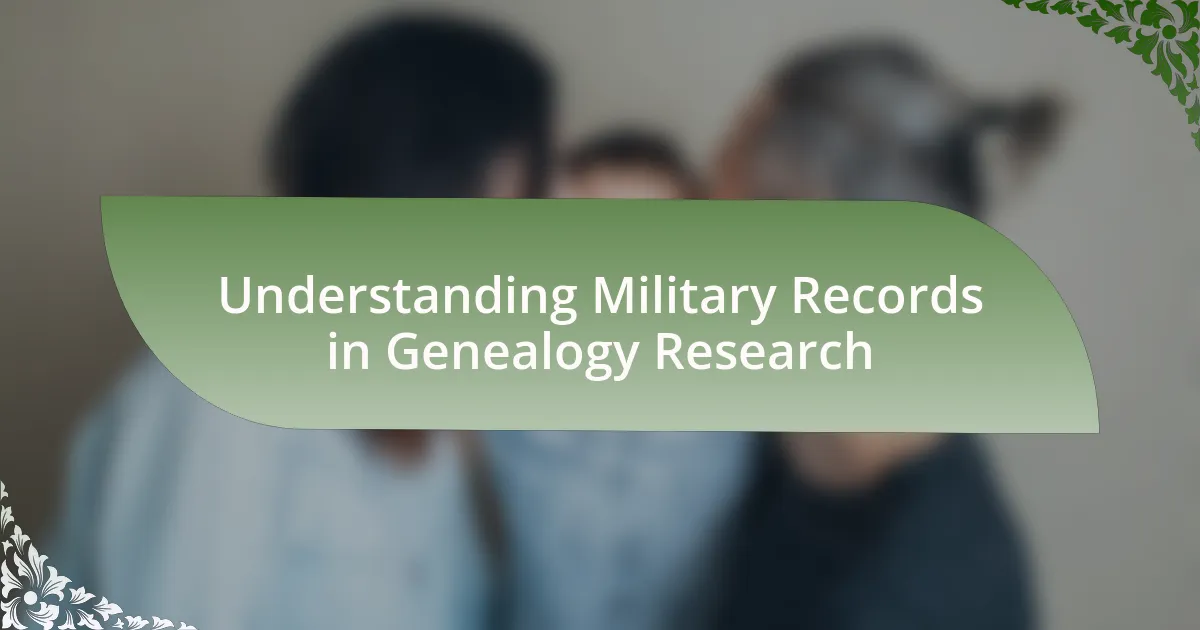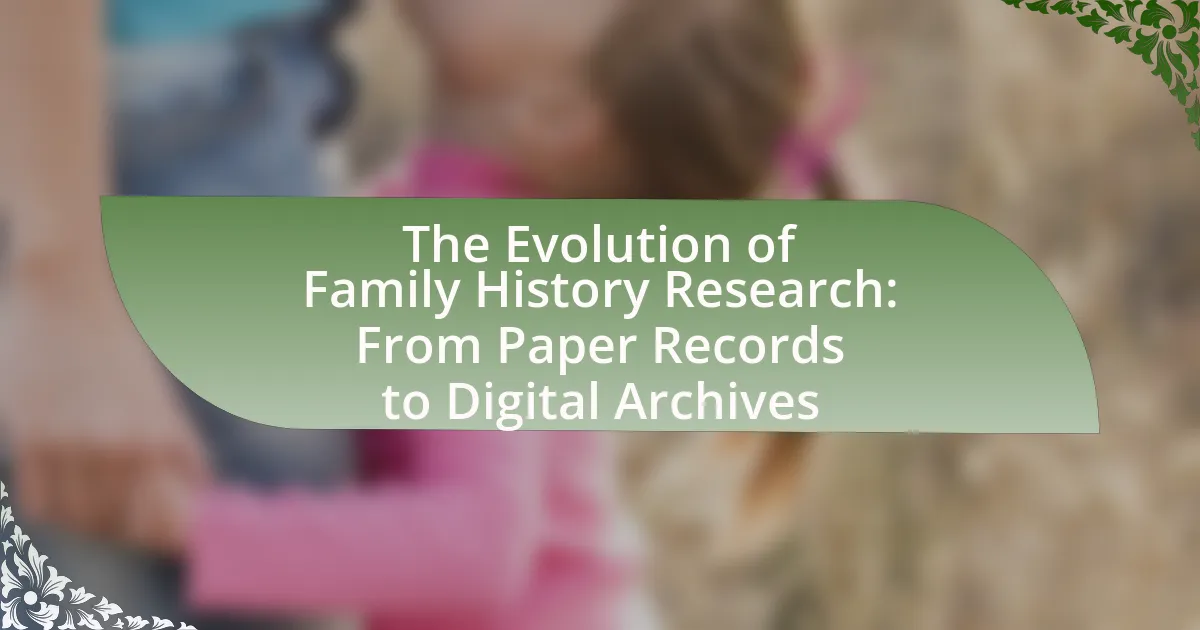Land grants and deeds are essential legal documents that establish ownership and rights to land, with land grants typically issued by government authorities and deeds serving as formal agreements between private parties. This article explores the differences between land grants and deeds, their legal implications, and their significance in genealogical research. It highlights how these documents can provide insights into ancestral lineage, property ownership, and historical context, while also addressing the challenges and best practices for utilizing them effectively in research. The article emphasizes the importance of thorough research and collaboration with experts to enhance understanding and interpretation of these valuable records.
What are Land Grants and Deeds?
Land grants and deeds are legal documents that convey ownership or rights to a specific parcel of land. Land grants are typically issued by governmental authorities, providing individuals or organizations with rights to use or own land, often for purposes such as agriculture, settlement, or development. Deeds, on the other hand, are formal written agreements that transfer property ownership from one party to another, detailing the rights and obligations associated with the property. These documents are essential for establishing legal ownership and can serve as historical records, providing insights into land use and ownership patterns over time.
How do Land Grants differ from Deeds?
Land grants differ from deeds primarily in their purpose and origin. Land grants are typically government-issued documents that convey land ownership or rights to individuals or organizations, often as part of a public policy or program, such as promoting settlement or development. In contrast, deeds are legal documents that transfer ownership of property from one party to another, usually between private individuals or entities.
Land grants often come with specific conditions or obligations, such as the requirement to cultivate the land or maintain it for public use, while deeds generally do not impose such conditions. Historical examples include the Homestead Act of 1862, which provided land grants to settlers in the United States, whereas a deed would simply document the sale or transfer of a property between two private parties without additional stipulations.
What legal implications are associated with Land Grants?
Land grants carry significant legal implications, primarily concerning property rights, land use regulations, and historical claims. These grants can establish ownership and usage rights, which may be contested or upheld in legal disputes. For instance, land grants issued by governments often come with stipulations regarding development, conservation, or agricultural use, which must be adhered to by the grantee. Additionally, historical land grants can affect current land ownership, as they may reveal ancestral claims or rights that could influence modern property disputes. Legal precedents, such as the case of United States v. Santa Fe Pacific Railroad Co., illustrate how land grants can be interpreted in court, impacting the rights of current landowners and the obligations of governmental entities.
How do Deeds serve as proof of ownership?
Deeds serve as legal documents that provide definitive proof of ownership for real property. They contain essential information such as the names of the buyer and seller, a description of the property, and the signatures of the parties involved, which establishes a clear transfer of title. The recording of deeds in public land records further solidifies their validity, as it creates a public record that can be referenced to verify ownership. This process is governed by property law, ensuring that the information is legally binding and enforceable in a court of law.
Why are Land Grants and Deeds important for Ancestral Insights?
Land grants and deeds are crucial for ancestral insights because they provide documented evidence of land ownership and transfer, which can trace familial connections and heritage. These legal documents often contain names, dates, and locations that link individuals to specific properties, revealing patterns of settlement and migration. For instance, historical land grants issued by governments can indicate where ancestors lived and worked, thereby offering insights into their socioeconomic status and community ties. Additionally, deeds can uncover relationships between families through shared land ownership, enhancing the understanding of lineage and ancestry.
What historical context do Land Grants provide?
Land grants provide historical context by illustrating the patterns of land distribution and ownership in various regions, particularly during periods of colonization and expansion. These grants often reflect governmental policies aimed at encouraging settlement, agricultural development, and economic growth. For instance, in the United States, the Homestead Act of 1862 granted land to settlers, which facilitated westward expansion and significantly impacted indigenous populations and land use. This context reveals the socio-economic dynamics of the time, including the motivations behind land allocation and the resulting demographic changes.
How can Deeds reveal family lineage and property ownership?
Deeds can reveal family lineage and property ownership by documenting the transfer of property rights across generations. Each deed typically includes the names of previous owners, the legal description of the property, and the date of transfer, which allows for the tracing of ownership back through time. For example, historical property records can show a direct line of inheritance, indicating how property has been passed down within a family. Additionally, deeds often contain information about the relationships between parties involved, such as familial connections, which further clarifies lineage. This systematic record-keeping is essential for genealogical research and establishing legal claims to property.
How can Land Grants and Deeds be utilized for Research?
Land grants and deeds can be utilized for research by providing historical context and genealogical information about property ownership and lineage. These documents often contain names of landowners, dates of transactions, and geographical descriptions, which can help trace family histories and understand settlement patterns. For example, land grants issued in the 19th century can reveal migration trends and the establishment of communities, while deeds can show inheritance patterns and familial connections. Researchers can access these records through local archives, historical societies, or online databases, allowing for a comprehensive analysis of ancestral ties and land use over time.
What steps should be taken to access Land Grants and Deeds?
To access Land Grants and Deeds, individuals should first identify the relevant government office or agency that maintains land records, typically the county clerk or recorder’s office. Next, they should gather necessary information such as the property owner’s name, parcel number, or the specific location of the land. After that, individuals can visit the office in person or access their online database, if available, to search for the desired land grant or deed. Finally, they may need to request copies of the documents, which could involve filling out a form and paying a nominal fee. Accessing these records is supported by the fact that land grants and deeds are public documents, ensuring transparency and availability for research purposes.
Where can one find historical Land Grant records?
Historical Land Grant records can be found at the National Archives and Records Administration (NARA) in the United States. NARA holds a vast collection of land grant documents, including those issued by the federal government from the late 18th century onward. Additionally, state archives and local land offices may also possess historical land grant records specific to their regions, providing further resources for genealogical research.
What resources are available for researching Deeds?
Resources available for researching deeds include county recorder’s offices, online databases such as the National Archives, and local historical societies. County recorder’s offices maintain public records of property transactions, including deeds, which can be accessed for detailed information about land ownership. Online databases, like those provided by the National Archives, offer digitized records and indexes that facilitate remote research. Local historical societies often have archives and knowledgeable staff who can assist in locating specific deeds and understanding their historical context. These resources collectively provide comprehensive access to deed information essential for ancestral research.
How can these documents enhance genealogical research?
Land grants and deeds can significantly enhance genealogical research by providing concrete evidence of ancestral land ownership and residence. These documents often include names of individuals, relationships, and locations, which help establish family connections and migration patterns. For instance, land grants may reveal the names of heirs, thereby identifying family lineage, while deeds can indicate when families moved or expanded their properties. Historical records show that land ownership was a key indicator of social status and economic stability, making these documents invaluable for understanding the socio-economic context of ancestors.
What specific information can be extracted from Land Grants?
Land grants provide specific information such as the names of grantees, the legal description of the land, the date of the grant, and any conditions or restrictions associated with the grant. This information is crucial for understanding property ownership history, land use, and familial connections. For instance, historical land grants often include details about the original landowners, which can help trace lineage and property inheritance. Additionally, land grants may reveal geographical features and boundaries that were significant at the time of the grant, thus offering insights into the socio-economic context of the period.
How do Deeds contribute to understanding family histories?
Deeds contribute to understanding family histories by providing documented evidence of property ownership and transfers within families. These legal documents often include names, dates, and locations that can trace lineage and familial connections over generations. For instance, a deed may reveal that a property was passed down from one family member to another, indicating relationships and inheritance patterns. Additionally, deeds can offer insights into migration patterns, as they often reflect changes in residence and land acquisition, which are crucial for constructing a comprehensive family tree.
What are the challenges in utilizing Land Grants and Deeds?
The challenges in utilizing Land Grants and Deeds include issues related to historical accuracy, legal complexities, and accessibility of records. Historical accuracy can be compromised due to incomplete or poorly maintained records, which may lead to disputes over land ownership and boundaries. Legal complexities arise from varying state laws and regulations governing land grants, making it difficult for individuals to navigate the legal landscape effectively. Additionally, accessibility of records can be a significant barrier, as many land grants and deeds are stored in local archives or government offices that may not be easily accessible to the public, limiting research opportunities for ancestral insights.
What common issues arise when interpreting these documents?
Common issues that arise when interpreting land grants and deeds include ambiguous language, inconsistent terminology, and lack of context. Ambiguous language can lead to multiple interpretations of property boundaries or ownership rights, complicating the understanding of the document’s intent. Inconsistent terminology may result from changes in legal language over time, making it difficult to ascertain the precise meaning of terms used in older documents. Additionally, the lack of context, such as historical or geographical background, can hinder accurate interpretation, as the significance of certain clauses may not be clear without understanding the circumstances surrounding the document’s creation. These factors can lead to disputes over property rights and hinder the ability to trace ancestral lineage accurately.
How can language and terminology in historical documents create confusion?
Language and terminology in historical documents can create confusion due to changes in meaning over time and the use of archaic or region-specific terms. For example, the word “heir” in historical contexts may not align with modern legal definitions, leading to misinterpretations of inheritance rights. Additionally, terms like “lot” or “parcel” may have varied definitions based on local customs or laws at the time of the document’s creation, complicating the understanding of land ownership. Such discrepancies can result in misunderstandings about property boundaries, ownership, and rights, ultimately hindering accurate ancestral research.
What are the limitations of Land Grants and Deeds in genealogical research?
Land grants and deeds have several limitations in genealogical research, primarily due to incomplete records and potential inaccuracies. Many land records may not include detailed information about family relationships, making it difficult to establish direct lineage. Additionally, historical land transactions often lack consistency in naming conventions, which can lead to confusion when tracing family connections. Furthermore, records may be lost, damaged, or destroyed over time, particularly in areas affected by natural disasters or wars, limiting access to crucial information. Lastly, land grants and deeds may not reflect the full scope of a family’s history, as they often focus on property ownership rather than personal details, thereby providing an incomplete picture of ancestral insights.
How can one overcome these challenges?
One can overcome the challenges of utilizing land grants and deeds for ancestral insights by conducting thorough research and leveraging available resources. Engaging with local historical societies and archives can provide access to essential documents and expert guidance. Additionally, utilizing online databases and genealogy platforms can facilitate the discovery of relevant land records. According to the National Archives, land grants often contain valuable information about family lineage and property ownership, which can be crucial for tracing ancestry. By systematically gathering and analyzing these records, individuals can piece together their ancestral history more effectively.
What strategies can be employed to accurately interpret historical documents?
To accurately interpret historical documents, one effective strategy is to analyze the context in which the document was created, including the historical, social, and political circumstances of the time. Understanding the background helps clarify the intent and significance of the document. For example, land grants and deeds often reflect the legal and economic conditions of their era, such as land ownership laws and colonial policies. Additionally, cross-referencing documents with secondary sources, such as historical analyses or scholarly articles, can provide insights into the document’s relevance and accuracy. This method is supported by research indicating that contextual analysis enhances comprehension of historical texts, as demonstrated in studies on archival research methodologies.
How can collaboration with experts enhance research outcomes?
Collaboration with experts enhances research outcomes by integrating specialized knowledge and skills that improve the quality and depth of the research. When researchers work alongside experts, they gain access to advanced methodologies, critical insights, and a broader perspective on the subject matter. For instance, in the context of utilizing land grants and deeds for ancestral insights, experts in historical land use and genealogy can provide valuable context and interpretation of data that may not be apparent to general researchers. This collaboration can lead to more accurate conclusions and innovative approaches, ultimately resulting in richer and more impactful research findings.
What best practices should be followed when utilizing Land Grants and Deeds?
When utilizing Land Grants and Deeds, it is essential to conduct thorough research to verify the authenticity and historical context of the documents. This practice ensures that the information is accurate and relevant to ancestral insights. Additionally, maintaining organized records of all land grants and deeds, including their locations and associated families, enhances accessibility and usability for future reference. Engaging with local historical societies or genealogical organizations can provide valuable resources and expertise, further enriching the understanding of land ownership and its implications in family history.




